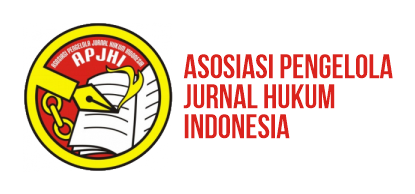Konstitusi Hijau Perancis: Komentar atas asas Kehati-hatian dalam Piagam Lingkungan Perancis 2004
DOI:
https://doi.org/10.31078/jk832Keywords:
precautionary principle, uncertainy, risk assessment, French ConstitutionAbstract
France is the first country that incorporates the precautionary principle into its constitution, via the 2004 Charter for the Environment. Based on the way the principle is formulated in the Charter, this paper attempts to show whether such an incorporation of the principle into French Constitution should be welcome as a progressive move. In addition, the paper demonstrates how the precautionary principle has been developed and adopted in various international environmental agreements or declarations. The paper also compares the French version of the principle with the development of the precautionary principle in Indonesian environmental law. The papers shows that interpreting the precautionary principle as risk assessment is not consistent with the intention of developing the precautionary principle, because risk assessment as currently conducted is plagued with a technocratic approach. The practices of risk assessment have oversimplified the situation of incertitude as merely risk, and consequently, has the potential to ignore public opinion and participation in the decision making process. In this sense, the French version of the precautionary principle is not quite progressive. In contrast, one Indonesian interpretation of the precautionary principle has moved beyond the issue of risk assessment. Such an interpretation, stemming from the court rulings on the Mandalawangi case, combines the precautionary principle with strict liability, by imposing liability to those who fail to take precautionary measures against uncertain damage.
References
Altieri, M.A. dan Rosset, P. “Strengthening the Case for Why Biotechnology Will not Help the Developing World: A Response to McGloughlin”. AgBioForum, Vol. 2(3&4), 1999b: hal. 226-236.
Anderson, L. Genetic Engineering, Food, and Our Environment: A Brief Guide. Devon, UK: Green Books, 1999.
Andow, D.A. dan Hutchison, W.D. “Bt-Corn Resistance Management”. Dalam: Mellon, M. dan Rissler, J. (eds.). Now or Never:Serious New Plans to Save a Natural Pest Control. Cambridge, MA: Union of Concerned Scientists, 1998. hal. 18-64.
Anonymous. “Bt Cotton through the Back Door”. Seedling, 18(4)
<http://www.grain.org/seedling/?id=151>, 2001. Diakses pada Agustus 2011.
Ashford, N.A. “A Conceptual Framework for the Use of the Precautionary Principle in Law”. Dalam: Raffensperger, C. dan Tickner, J. (eds.). Protecting Public Health and the Environment: Implementing the Precautionary Principle. Washington, DC: Island Press, 1999. Hal. 198-206..
Asshiddiqie, J. Green Constitution: Nuansa Hijau Undang-undang Dasar Negara Republik Indonesia Tahun 1945. Jakarta: Rajawali Press, 2009.
Boehmer-Christiansen, S. “The Precautionary Principle in Germany— Enabling Government”. Dalam: O’Riordan, T. dan Cameron, J. (eds.). Interpreting the Precautionary Principle. London: Earthscan Publications, 1994. Hal. 31-60.
Bratspies, R. “The Illusion of Care: Regulation, Uncertainty, and Genetically Modified Crops”. New York University Environmental Law Journal, Vol. 10, 2002: hal. 297-355.
Cameron, J. “The International Principle in International Law”. Dalam: O’Riordan, T.; Cameron, J.; dan A. Jordan (eds.). Reinterpreting the Precautionary Principle. London: Cameron May, 2001. Hal. 113-142.
Cameron, J.; Wade-Gerry, W. dan Abouchar, J. “Precautionary Principle and Future Generation”. Dalam: Agius, E., et al.(eds.). Future Generation and International Law. London: Earthscan Publications, 1998. Hal. 93-113.
Conko, G. “Safety, Risk, and the Precautionary Principle: Rethinking Precautionary Approaches to the Regulation of Transgenic Plants”. Transgenic Research, Vol. 12, 2003: hal. 639-647.
Conner, A.J.; Glare, T.R. dan Nap, J.P. “The Release of Genetically Modified Crops into the Environment. Part II: Overview of Ecological Risk Assessment”. The Plant Journal, Vol. 33, 2003: hal. 19-46.
Craik, A.N.; Siebrasse, N. dan Culver, K.C. “Genetically Modified Crops and Nuisance: Exploring the Role of Precaution in Private Law”. Bulletin of Science, Technology & Society, Vol. 27(3), 2007: hal. 202-214.
Cramer, B.W. “The Human Right to Information, the Environment and Information about the Environment: From the Universal Declaration to the Aarhus Convention”. Communication Law and Policy, Vol. 14, 2009: hal. 73-103.
Ellstrand, N.C. “When Transgenes Wander, Should We Worry?”.
Plant Physiology, Vol. 125, 2001: hal. 1543-1545.
Ely, A. “Regulatory Appraisals of Bt Maizes: A Study of Science in Governance Vol. 1 & 2”. Dissertation in Science and Technology Policy, University of Sussex, 2006.
ESRC-Global Environmental Change Programme. “The Politics of GM Foods: Risk, Science, and Public Trust”. Special Briefing, No. 5, 1999.
Faure, M. dan Wibisana, A. “Liability for Damage Caused by GMOs: an Economic Perspective”. Georgetown International Environmental Law Review, Vol. 23(1), 2010: hal. 1-69.
Fisher, E. dan Harding, R. “The Precautionary Principle: Toward a Deliberative, Transdisciplinary Problem-Solving Process”. Dalam: Harding, R. dan Fisher, E. (eds.). Perspectives on the Precautionary Principle. Leichhardt, NSW: The Federation Press, 1999. 290-298.
Gala, R. “GM Cotton Fiascos Around the World”. Dari: http:// www.i-sis.org.uk/GMCFATW.php. Diakses tanggal 13 Agustus 2011.
Garret, N. “Life is the Risk We Cannot Refuse: A Precautionary Approach to The Toxic Risks We Can”. Georgetown International Environmental Law Review, Vol. 17, 2005: hal. 517-562.
Geistfeld, M. “Implementing the Precautionary Principle”.
Environmental Law Reporter, Vol. 31, 2001: hal. 11326-11333.
Godard, O. “The Precautionary Principle and Catastrophism on Tenterhooks: Lessons from a Constitutional Reform in France”. Dalam: Fisher, E.; Jones, J. dan Von Schomberg, R. (eds.). Implementing the Precautionary Principle: Perspective and Prospects. Cheltenham, UK: Edward Edgard, 2006. Hal. 63-87.
Gollier, C. dan Treich, N. “Decision-Making under Scientific Uncertainty: The Economics of the Precautionary Principle”. Journal of Risk and Uncertainty, Vol. 27(1), 2003: hal. 77-103.
Grubb, M. “Seeking Fair Weather: Ethics and the International Debate on Climate Change”. International Affair, Vol. 71(3), 1995: hal. 463-496.
Harremoës, P., et al. (eds.). Late Lessons From Early Warnings: The Precautionary Principle 1896-2000. Copenhagen: European Environment Agency, 2001.
Holm, S. Dan Harris, J. “Precautionary Principle Stifles Discovery”. Nature, Vol. 400, 1999: hal. 398.
Hunter, D.; Salzman, J; dan Zaelke, D. (eds.). International Environmental Law and Policy. New York: Foundation Press, 1998.
Jordan, A. dan O’Riordan, T. “The Precautionary Principle in Contemporary Environmental Policy and Politics”. Dalam: Raffensperger, C. dan Tickner, J. (eds.). Protecting Public Health and the Environment: Implementing the Precautionary Principle. Washington, DC: Island Press, 1999. Hal. 15-35.
Khanna, N. dan Chapman, D. “Time Preference, Abatement Costs, and International Climate Policy: An Appraisal of IPCC 1995”. Contemporary Economic Policy, Vol. XIV, 1996: hal. 56-66.
Khoury, L. dan Smyth, S. “Reasonable Foreseeability and Liability in Relation to Genetically Modified Organisms”. Bulletin of Science, Technology and Society, Vol. 27(3), 2007: hal. 215-232.
Li, T.C. “Farmer’s Bane: GMOs”. The Star, 2 Maret 2004. Dikutip dari: http://www.mindfully.org/GE/2004/Farmers-Bane- GMOs2mar04.htm. Diakses tanggal 13 Agustus 2011.
Marchant, G.E. “From General Policy to Legal Rule: Aspirations and Limitations of the Precautionary Principle”. Environmental Health Perspective, Vol. 111(14), 2003: hal. 1799–1803.
Marrani,D. “Human Rights and Environmental Protection: The Pressure of the Charter for the Environment on the French Administrative Courts”. Sustainable Development Law and Policy Vol. 10, 2009: hal. 52-57.
May, J.R. “Constituting Fundamental Environmental Rights Worldwide”. Pace Environmental Law Review, Vol. 23, 2005- 2006: hal. 113-182.
Miller, H.I. dan Conko, G. “Precaution without Principle”. Nature Biotechnology, Vo. 19 (4), 2001: hal. 302-303.
Morris, J. “The Relationship between Risk Analysis and the Precautionary Principle”. Toxicology, Vol. 181-182, 2002: hal. 127-130.
Nollkaemper, A. “What You Risk Reveals What You Value and Other Dilemmas Encountered in the Legal Assault on Risks”. Dalam: Freestone, D. dan Hey, E. (eds.). The Precautionary Principle and International Law: The Challenge of Implementation. The Hague: Kluwer Law International, 1996. Hal. 73-94.
Pardy, B. “Applying the Precautionary Principle to Private Persons: Should it Affect Civil and Criminal Liability?”. Les Cashiers de Droit, Vol. 43(1), 2002: hal. 63-78.
Pedersen, W. “European Environmental Human Rights and Environmental Rights: A Long Time Coming?”. Georgetown International Environmental Law Review, Vol. 21, 2008: hal. 73-111.
Puder, M.G. “The Rise of Regional Integration Law (RIL): Good News for International Environmental Law (IEL)?”. Georgetown International Environmental Law Review, Vol. 23, 2011: hal. 165-201.
Regev, U. “Pest Resistance in Agriculture: An Economic Perspective”. Dalam: Swanson, T. (ed.). The Economics of Managing Biotechnologies. Dordrecht: Kluwer Academic Publishers, 2002. Hal. 51-69.
Royal Society of Canada. “Elements of Precaution: Recommendations for the Regulation of Food Biotechnology in Canada: An Expert Report on the Future of Biotechnology”. 2001. Diakses dari: http://www.rsc.ca/foodbiotechnology/GMreportEN.pdf;
Sandin, P. “The Precautionary Principle and the Concept of Precaution”. Environmental Value, Vol. 13, 2004: hal. 461-475.
Santillo, D., et al.. “The Precautionary Principle: Protecting Against Failures of Scientific Method and Risk Assessment”. Marine Pollution Bulletin, Vol. 36(12), 1998: hal. 935-950.
Saraswati, M.S. “KPK to investigate Monsanto Bribery Case”. The Jakarta Post, 1 Oktober 20105. Tersedia pada: http:// www.thejakartapost.com/news/2005/01/10/kpk-investigate- monsanto-bribery-case.html. Diakses tanggal 13 Agustus 2011.
Shavell, S. “An Analysis of Causation and the Scope of Liability in the Law of Torts”. Journal of Legal Studies, Vol. 9(3), 1980: hal. 463-516.
Steinemann, A. “Rethinking Human Health Impact Assessment”. Environmental Impact Assessment Review, Vol. 20, 2000: hal. 627-645.
Sunstein, C.R. Laws of Fear: Beyond the Precautionary Principle. Cambridge: Cambridge University Press, 2005..
Sunstein, C.R. “Beyond the Precautionary Principle”. University of Pennsylvania Law Review, Vol. 151(3), 2003: hal. 1003-1058.
Tabashnik, B.E. “Evolution of Resistance to Bacillus thuringiensis”. Annual Review of Entomology, Vol. 39, 1994: hal. 47-79.
Tickner, J. dan Raffensperger, C. “The Precautionary Principle in Action: A Handbook”. First edition, written for Science and Environmental Health Network (SEHN). http://www.biotech_info.net/handbook.pdf. Diakses pada tanggal 26 Maret 2004.
Trewavas, A.J. dan Leaver, C.J. “Is Opposition to GM Crops Science or Politics?”. EMBO Reports, Vol. 2(6), 2001: 455-459.
Tridimas, T. “Proportionality in Community Law: Searching for the Appropriate Standards of Scrutiny”. Dalam: Ellis, E. (ed.). The Principle of Proportionality in the Laws of Europe. Oxford: Hart Publishing, 1999. Hal. 65-84.
Trouwborst, A. Evolution and Status of the Precautionary Principle in International Law. The Hague: Kluwer Law International, 2002.
Van Gerven, W. “The Effect of Proportionality on the Actions of Member States of the European Community: National Viewpoints from Continental Europe”. Dalam: E. Ellis (ed.). The Principle of Proportionality in the Laws of Europe. Oxford: Hart Publishing, 1999. Hal. 37-63.
Van Zwanenberg, P. dan Stirling, A. “Risk and Precaution in the US and Europe: A Response to Vogel”. Dalam: Somsen, H. et al. (eds.). The Yearbook of European Environmental Law Vol. 3. Oxford: Oxford University Press, 2003. Hal. 43-56.
Von Moltke, K. “The Relationship between Policy, Science, Technology, Economics and Law in the Implementation of the Precautionary Principle”. Dalam: Freestone, D. dan Hey, E. (eds.). The Precautionary Principle and International Law: The Challenge of Implementation. The Hague: Kluwer Law International, 1996. Hal. 97-108.
Putusan
Putusan PTUN Jakarta No. 71/G.TUN/2001/PTUN-JKT
Putusan PT TUN Jakarta No. 120/2001/Bd.071/G.TUN/2001/ PTTUN. JKT.
Putusan PN Bandung No. 49/Pdt.G/2003/PN.BDG. Putusan PT Bandung No. 507/PDT/2003/PT.Bdg.
Putusan MA No. 1794 K/Pdt/2004.
Downloads
Published
How to Cite
Issue
Section
License
Authors who publish with this journal agree to the following terms:
- Copyright of the published articles will be transferred to the journal as the publisher of the manuscripts. Therefore, the author confirms that the copyright has been managed by the publisher.
- The publisher of Jurnal Konstitusi is The Registrar and Secretariat General of the Constitutional Court of the Republic of Indonesia.
- The copyright follows Creative Commons Attribution-NonCommercial-ShareAlike 4.0 International License: This license allows reusers to distribute, remix, adapt, and build upon the material in any medium or format for noncommercial purposes only, and only so long as attribution is given to the creator. If you remix, adapt, or build upon the material, you must license the modified material under identical terms.

















